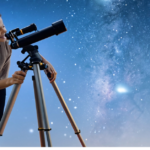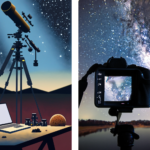So, you’ve decided to embark on this star-streaked journey called astrophotography. I can’t blame you, the universe is a captivating canvas that would make anyone want to capture its beauty. Before you grab your gear and out start venturing into the night, though, you’ll need some guidance. Lo and behold, the wonders of technology have brought forth a variety of astrophotography apps to assist you in your celestial pursuits.
But, which apps should you choose? Now, that’s a question as vast as the universe itself. Don’t worry, I’ve got your back. I’ve spent countless nights under the stars, wrestling with different apps, and now I’m here to share my top picks with you. These apps are not just the stars, they’re whole galaxies when it comes to planning your astrophotography sessions. Let’s dive in, shall we?
Astrophotography apps can help amateur astronomers capture better images of the night sky.
How to Choose Astrophotography Apps
There are a few steps you should follow if you are trying to choose an astrophotography app. Here is what I advise:
- Decide what you need from the app. What exactly do you need it to do?
- Search for the app using suitable keywords in the Apple App Store or Google Play.
- When you find something check the popularity and reviews of the app to see what others think.
- What is the average rating out of five? Anything above 4 or 4.5 is worth trying out.
- Compare the features of similar apps and select one to install on your phone.
The best way to choose suitable apps is to actually try them out for a while so look for apps that allow you to try them for a limited time for free or download an app that can be used free and upgraded later.
Choosing an astrophotography app can be a matter of trial and error so do follow the advice I give on this page and you should soon find the best apps for your application.
My Selection of the Best Astrophotography Apps
Some popular astrophotography apps include SkySafari, Star Walk 2, and NightCap Camera. But what are my own personal choices?
Here are the Astro apps that I’ve found useful:
- Sky Safari
- Clear Outside
- Polar Scope Align Pro
- Light Pollution map
- Stellarium
- Telescopius
Let’s take a closer look at each one of these.
1. Sky Safari
by Simulation Curriculum Corp. 4.7/ 5 rating on Apple’s App Store.
The download is free. The cost is $2.99 for the App.
I use Sky Safari in a few different ways. When I open the app on my iPhone and point it at the sky I can see where the Milky Way is. This is very helpful because my location has a Bortle 5 level sky and I cannot see the Milky Way at all. The app helps me identify where it is. Why would I want to do this?
There are two reasons why this is useful. I can shoot photos of the Milky Way over my house or local area and I can locate some of the most impressive deep sky objects as they lie within the Milky Way core.
I find Sky Safari easy to use and I can see which stars I can use to align my telescope. It also helps me find objects in the sky.
2. Clear Outside
This app helps me to plan my astrophotography shooting sessions because it tells me the weather conditions I can expect in my selected location. It is also very useful for finding the Bortle sky light pollution level of any place. This is extremely helpful when I visit a new area or when I am looking for darker conditions than I have at home.
It has an easy-to-read layout and is colour coded to make it immediately obvious if the sky is clear and if it will be windy at different times of the night. Another feature that I like is the information it gives about the moon. In astrophotography, it is important to know how much illumination will be coming from the moon and when it will rise and set.
3. Polar Scope Align Pro
I originally downloaded and used the Polar Scope Align app to set up polar alignment on my Ioptron CEM 26 equatorial mount. The app shows me exactly where I need to place Polaris in my polar scope reticule. I used it like this for a while but decided to update and get the Pro version because it showed in more accurate detail exactly where Polaris should be placed in my polar scope.
I found that my polar alignment was improved significantly when using the Pro version and it was relatively cheap to upgrade.
This app is still on my phone and if I find myself without my laptop I could use this for a quick polar alignment. If you want to do a manual alignment this is the app for you!
4. Light Pollution Map
This is a great app that does what it says on the tin. I use it to scout out local places where the light pollution levels are lower and the skies darker. In these areas, I can get clearer photographs of the Milky Way and other deep sky objects such as the nebulae that I usually try to capture.
The app is free and works like a charm on my iPhone!
It has many features including:
- Light Pollution map which is colour coded to indicate the Bortle level.
- Night event calendar which shows the major astronomy events such as meteor showers etc.
- Aurora map – this gives an aurora forecast in both the Northern and Southern hemispheres.
- Data on the Sun with images.
- Information about the moon phase.
The pro version which is a paid upgrade has even more features but the free version is great!
5. Stellarium
This app is free and the version that I use is on my Windows laptop. I use it for two reasons. First, to check which objects I can photograph in the sky and where they are. Also to see what they will look like in my field of view as I have my camera (ZWO 533MCPRO) and telescope (Celestron 130slt OTA) set up in the software.
I also run the time forwards to check where the object will be at certain times throughout the night. I also use Stellarium to select suitable targets before I start imaging.
This gets a big thumbs up from me in terms of practicality!
6. Telescopius
This is an online app that I use mainly to create astrophotography mosaics created from different panels. This is useful for when objects do not fit into my FOV because they are too large. An example is the North American Nebula, which requires 6-7 panels with my equipment to create a good image of the entire object.
My telescope has a focal length of 650mm and so some targets need to be shot with more than one panel. The Telescopius website has a fantastic telescope simulator that allows you to enter the details of your equipment (camera, optics, and telescope) and then it will create a grid of panels to image the object you want to photograph.
Check the image below to see what this looks like.

Are there any free astrophotography apps?
There are a few that are completely free such as Clear Outside and Light Pollution Map, and I’ve used them. Of course, there is always the opportunity to pay a small amount and upgrade them. The apps I have selected are worth paying the small charge for.
Can I edit my astrophotography images using an app?
You can but I wouldn’t really recommend it. For example, lightroom and a few others have a mobile app. Some might want to use these but I find that a bigger monitor and a desktop are far more likely to help you produce quality astrophotos.
Finding the best photo editing apps for astrophotography
One thing you can do is to check which are the most downloaded apps that astrophotographers use. I’ve compiled a list below:
The Most Downloaded Astrophotography Apps
So, you want to start astrophotography and you’re not sure which apps to go for? Well, you’re in luck. Here’s a nifty little table I’ve put together, showing the most downloaded astrophotography apps – a clear sign of their popularity, and probably, their effectiveness. Let’s take a look, shall we?
| App | Number of Downloads |
|---|---|
| Star Walk 2 | Over 10 million |
| Star Tracker | Over 10 million |
| SkyView | Over 1 million |
| Night Sky Tools | Over 1 million |
| Mobile Observatory 3 | Over 500,000 |
| Night Cap Camera | 500,000 |
| Sky Safari | 100,000 |
Remember, while the number of downloads might be a good indicator of an app’s popularity, it doesn’t necessarily mean it’s the best fit for you. Different apps have different features and strengths, so don’t forget to explore a bit!
More About These Apps
Alright, space cowboys and cowgirls, let’s saddle up and take a gander at some of the best astrophotography apps I’ve come across on my interstellar journey. I’ve met a few shooting stars and black holes along the way, but these apps are genuinely out-of-this-world!
SkyView Lite
If you’re just dipping your toes into the Milky Way, SkyView Lite is a fantastic place to start. It’s user-friendly, and it’s free. Yes, you heard it right, it’s as free as a bird in zero gravity. What more could you want?
It’s an excellent app that allows you to identify and find planets and stars and more in the night sky using your mobile phone.
Read this review of Sky View Lite
Night Sky
Next up is Night Sky, an app that is just as intriguing as its name suggests. Now, let me ask you this: have you ever gazed up at the night sky, utterly mesmerized, but also entirely confused? This app is a planetarium in your pocket! Star Tracker
This astrophotography app has many features including the following:
- This app is great for stargazing as it shows you planets, constellations, and deep sky objects as you point your phone at the sky.
- Great for learning how to find objects in the night sky.
- Kids also seem to love it!
- Check out the features and more here.
Night Cap Camera
This is one best astrophotography apps for iPhone that I have used when I wanted to extend the use of my iPhone and take some longer exposure shots. The app itself is very good but I can’t recommend using an older iPhone for astrophotography. Some of the newest high-resolution mobile phone models can give good results.
Sky Safari
A favourite of mine and still use it every time I go out imaging with my telescope. I’ve reviewed it above.








